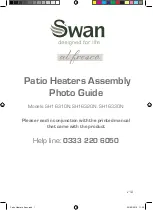
FAULT FINDING
SECTION 7
18
FAULT
1. WATER DOES NOT
GET HOT
2. PILOT FLAME
IS OUT
3. PILOT WILL NOT
STAY ON
4. BURNER WILL
NOT LIGHT -
PILOT
ESTABLISHED
5. THERMOCOUPLE
BURNS OUT
FREQUENTLY
6. HEATER SOOTING,
YELLOW FLAME
(POOR
COMBUSTION)
7. WATER
TEMPERATURE
TOO HIGH
8. WATER
TEMPERATURE
TOO LOW
9. NOT ENOUGH
HOT WATER
10. WATER DRIPPING
FROM BASE OF
HEATER
11. RUMBLING NOISE
(KETTLING)
ACTION
(a) Check gas cock is open.
(b) Check water valves are open.
(c) Check that pilot is alight.
(d) Check thermostat setting. (Reset to higher temperature).
(e) Check gas pressures at burner and at gas inlet to appliance.
(f) Check cold inlet dip tube to see if it is broken or missing (see Fig. 10).
(a) Try to light burner as detailed in lighting instructions.
(b) Pilot will not light wait 3 mins and try again then see below.
(a) Check gas available.
(b) Check thermocouple, replace if necessary.
(c) Check inlet gas pressure as this may be too high or too low.
Inlet gas pressure to heater multifunctional control should be 17.5
mbar (7”Wg) to 25 mbar (10”Wg).
(d) Pilot jet blocked, clean or replace pilot jet.
(e) Faculty magnet, replace multifunctional control.
(f) E.C.O. safety thermostat operating at too low a temperature. Replace
multifunctional control.
(a) Water already at correct temperature.
(b) Replace multifunctional control.
(a) Check pilot pipe for loose joints.
(b) Check that correct amount of fresh air ventilation is available.
(c) Check that flue is clear and is correctly designed and fitted.
(d) Check for presence of halogen vapours (see page 7).
(a) Clean burner and injector.
(b) Flue obstruction, clean flueways.
(c) Check flue design and termination position.
(d) Check burner pressure.
(e) Check for correct ventilation.
(a) Reset thermostat to lower temperature.
(b) If water temperature is still too high replace multifunctional control.
(a) Reset to higher temperature.
(b) Check gas pressures at burner and at gas inlet to appliance.
(a) Check gas pressures at burner and at gas inlet to appliance.
(b) Check amount of water being used against recovery rate given on
Data Plate.
(a) Check if water stops dripping when water in heater is hot. If water
stops problem is condensation caused by incorrectly designed flue or
by tank cooling excessively i.e. more hot water being used than
recovery rate of the heater.
(b) If water continues to drip when heater is hot. Problem is a leaking
joint or storage vessel.
(a) Scale formation in heater, consult water treatment specialist. Heater
must be descaled and suitable water treatment provided to avoid
problem re-occurring.
Fig. 10
Removal of
Cold Inlet Dip Tube
& Hot Outlet
Nipple/Anode
Disconnect pipe fittings and turn nipple anti clockwise to remove.







































